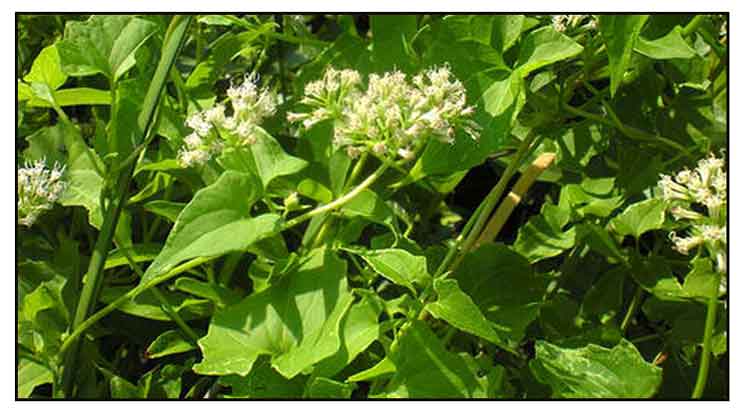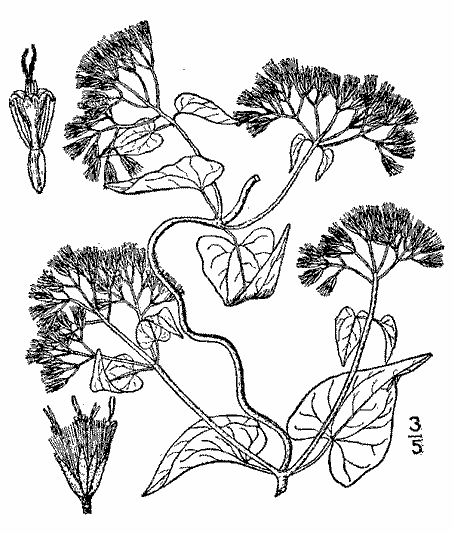
Family • Asteraceae
Bikas
Mikania cordata (Burm.f.) B.L. Rob.
HEARTLEAF HEMPVINE
Mi gan cao
| Scientific names | Common names |
| Eupatorium cordatum Burm.f. | Bikas (Tag.) |
| Eupatorium cordatum var. cordatum | Detitid (Ig.) |
| Eupatorium trinitarium var. volubilis (Poepp.) M. Gomez | Tamburakan (Tagb.) |
| Eupatorium volubile Norona | Uoko (Bon.) |
| Eupatorium volubile (Poepp.) Vahl | Bikas (Tag.) |
| Knautia sagitata Blanco | Climbing hemp weed (Engl.) |
| Mikania cordata (Burm.f.) B.L. Rob. | Heartleaf hempvine (Engl.) |
| Mikania cordata f. cordata | Mile-a-minute (Engl.) |
| Mikania cordata var. cordata | |
| Mikania sagitata Blanco | |
| Mikania volubilis (Vahl.) Willd. | |
| Mikania volubilis Poepp. | |
| Mikania cordata (Burm.f.) B.L.Rob. is an accepted name. The Plant List | |
| Other vernacular names |
| CHINESE: Mi gan cao, Jia ze lan. |
| FRENCH: Liane marzoge, Liane Pauline, Liane raisin |
| INDONESIA: Brojo lego (Javanese), blukar (Sumatra), hila hitu lama (Ambon). |
| KWARA'AE: Kwalo ngingilo. |
| MALAYSIA: Akar lupang, ceroma, selaput tunggul. |
| SAMOAN : Fue saina, Fue sega. |
| THAILAND : Khikaiyan |
| OTHERS: Eskwater. |
Updated April 2017 / July 2014
![]()
 |
| Content © Godofredo Stuart / StuartXchange |
| IMAGE SOURCE: Photo / Leaves and flowers of Heartleaf hempvine / Mikania scandens (L.) Willd / Vietnam Plants & American Plants / Phuong Tran / flickr / click on image to go to source page |
| IMAGE SOURCE: Mikania scandens (L.) Willd. - climbing hempvine / Britton, N.L., and A. Brown. 1913. An illustrated flora of the northern United States, Canada and the British Possessions. 3 vols. Charles Scribner's Sons, New York. Vol. 3: 363. Courtesy of Kentucky Native Plant Society. / USDA |
| Additional
Sources and Suggested Readings (1) Anticarcinogenic biological response of Mikania cordata: reflections in hepatic biotransformation systems / Anupam Bishayee and Malay Chatterjee / Cancer Letters, Vol 81, Issue 2, 30 June 1994, Pages 193-200 /doi:10.1016/0304-3835(94)90202-X (2) Chemical constituents of the essential oil of Mikania cordata (Burm.f.) B.L. Robinson from Abidjan (Ivory Coast) / Bedi, G, Tonzibo, Z F, N'Guessan et al / Journal of Essential Oil Research: JEOR, May/Jun 2003 (3) Pharmacological studies of the antiinflammatory profile of Mikania cordata (Burm) B. L. robinson root extract in rodents / S Bhattacharya, S Pai et al / Phytotherapy Research, Vol 6, Issue 5, pages 255–260, September/October 1992 / DOI: 10.1002/ptr.2650060507 (4) The anti-ulcerogenic effect of an alkaloidal fraction from Mikania cordata on diclofenac sodium-induced gastrointestinal lesions in rats / ASHIK MOSADDIK M, FAISAL ALAM K. M. / Journal of pharmacy and pharmacology, 2000, vol. 52, no9, pp. 1157-1162 (5) Mikania cordata / common name details from PIER (6) Mikania cordata (Burm.f.) B.L. Robinson / Vernacular names / GLOBinMED (7) Pharmacological studies of the antiinflammatory profile of Mikania cordata (Burm) B. L. robinson root extract in rodents / S. Bhattacharya, S. Pal and A. K. Nag Chaudhuri* / Phytotherapy Research, Volume 6, Issue 5, pages 255–260, September / October 1992 / DOI: 10.1002/ptr.2650060507 (8) Antibacterial and Cytotoxic Activity of Ethanol Extract of Mikania Cordata (Burm.F.) B.L. Robinson Leaves / Md. Sekendar Ali, Md. Saiful Islam, Md. Masudur Rahman, Md. Rabiul Islam, Mohammed Aktar Sayeed and Md. Rafikul Islam / Journal of Basic and Clinical Pharmacy (9) Study of chemical constituents of essential oil from flowers of Mikania micrantha H.B.K / Shao H, Nan P, Peng S, Zhang C. / Zhong Yao Cai. 2001 May;24(5):341-2. (10) The Analysis of Aquoues and Ethanolic Extracts of Malaysian Mikania Cordata Leaves towards the Potential for Medicinal Substances / Ab Patar, A and Badrul Hisham Yahaya / European Journal of Scientific Research ISSN 1450-216X Vol.73 No.4 (2012), pp. 434-440 (11) Neuropharmacological Studies on Mikania cordata Root Extract / Siddhartha Bhattacharya, Siddhartha Pal, A. K. Nag Chaudhuri / Planta Med 1988; 54(6): 483-487 / DOI: 10.1055/s-2006-962524 (12) Toxicological and Antimicrobial Evaluations of Formulated Ointment from Eskwater (Mikania cordata Asteraceae) Leaf Extract against Trichophyton mentagrophytes and Methicillin-Resistant Staphylococcus aureus / Judee N. Nogodula, Lady Ron M. Ducut, Jelah Mae F. Edorot, Aizovelle T. Egagamao / University of the Immaculate Conception Research Journals, Vol 18, No 2 (2012) (13) IN VITRO & IN VIVO EVALUATIONS OF MIKANIA CORDATA (BUMR.F.) B.L. ROBINSON EXTRACT / Latifa Bulbul*, Asma Ferdowshi, Mohammad Sazzad Rahman, Somen Mojumder Sushanta, Shahnaj Tanni, Md. Jahir Uddin / Indo American Journal of Pharmaceutical Research, Vol 3, Feb 2013 (14) Safety and Efficacy of Herbal Ointment formulated with Methanolic extract of Mikaniacordata as Treatment for Acute Superficial Injury / BarnabasE.Herbert,*Loraine M.Bagares, RaimeR.Galang, Katherine Garcines, Sherwin S. Go, May A. Jalamana / bcjournal-brokenshire.edu (15) Mikania cordata / Synonyms / The Plant List (16) Anti-Cancer Effect and Mechanisms of Action of Mikania cordata Plant Extract on MCF-7 Human Breast Adenocarcinoma Cells./ T.G.C. Uy, A.M. Licuanan, G.E.D. Angeles, M.L.C.C. Bote, E.A.B. Macauyag, C.C. Hernandez, S.D. Jacinto and R.M. Guzman-Genuino, 2015. International Journal of Cancer Research, 11: 80-92. / DOI: 10.3923/ijcr.2015.80.92 (17) Evaluation of phytochemical and pharmacological properties of Mikania cordata (Asteraceae) leaves / Abdullah Al Nayeem, Amina Khatun, Md. Shafiur Rahman and Mahmudur Rahman* / Journal of Pharmacognosy and Phytotherapy Vol. 3(8), pp. 118-123, September 2011 / http://www.academicjournals.org/JPP (18) In vitro phytochemical, cytoxicity and mineral composition analyses of Micania Cordata (Bumr.f.) B.L. robinson leaves / Nobel Barua*, Nurul Absar, Sudip Paul, Anik Barua, Md. Yeashin Gazi, Moumoni Saha, Mohammad Shariful Islam, Jannatul Marium Belaly / International Journal of Biosciences, IJB, Vol. 5, No. 8, p. 154-160, 2014 (19) In vivo antidiarrheal study of ethanolic extracts of Mikania cordata and Litsea monopetala leaves / Fatema Nasrin, Md. Lukman Hakim / Bangladesh Journal of Pharmacology, Vol 10, No 3 (2015) (20) Protective effects of Mikania cordata root extract against physical and chemical factors-induced gastric erosions in experimental animals. / Bishayee A , Chatterjee M / Planta medica 60:2 1994 Apr pg 110-3 (21) Effect of Mikania cordata on Non-Specific Immune Response and Survival of Labeo Rohita Against Aphanomyces Invadans / V. Kumar, S. Roy and D. Barman / The Journal of Animal & Plant Sciences, 26(6): 2016, Page: 1833-1842 (22) Toxicological and Antimicrobial Evaluations of Formulated Ointment from Eskwater (Mikania cordata Asteraceae) Leaf Extract against Trichophyton mentagrophytes and Methicillin-Resistant Staphylococcus aureus / Judee N. Nogodula / UIC Research Journal, Vol. 18 no. 2 (2012) (23) FREE RADICAL SCAVENGING ACTIVITY OF SIX MEDICINAL PLANTS OF BANGLADESH: A POTENTIAL SOURCE OF NATURAL ANTIOXIDANT / Shakhawat Hossain, Jahidul Islam, Firoj Ahmed, Md. Amjad Hossain, Mohammad Abdul Kaium Siddiki and S. M. Moazzem Hossen / J App Pharm Vol. 7; Issue 1: 96-104; January, 2015 |
| It is not uncommon for links on studies/sources to change. Copying and pasting the information on the search window or using the DOI (if available) will often redirect to the new link page. |
• |
 |
• |



